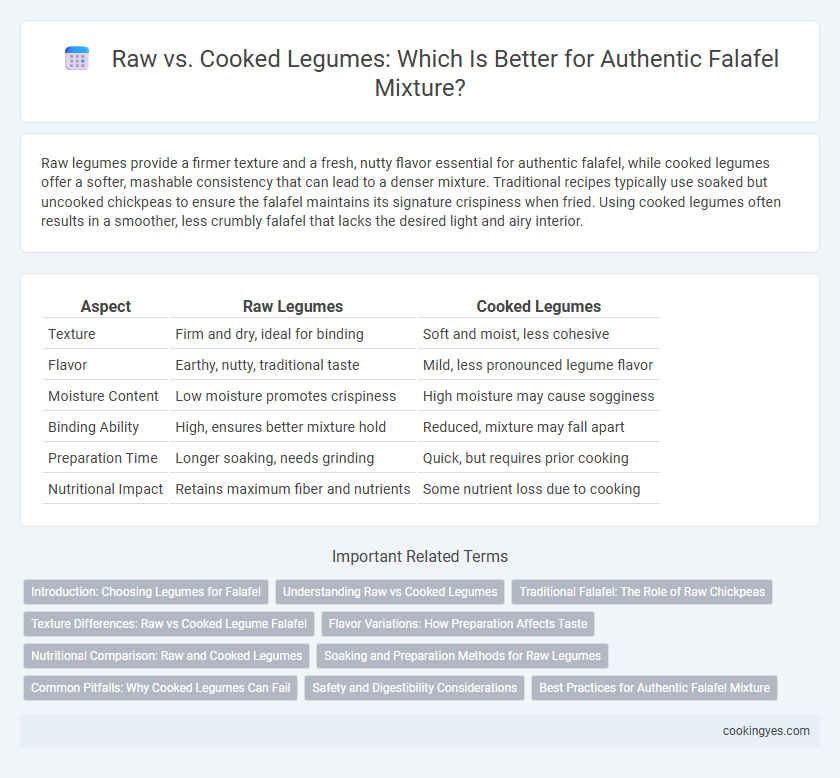Raw legumes provide a firmer texture and a fresh, nutty flavor essential for authentic falafel, while cooked legumes offer a softer, mashable consistency that can lead to a denser mixture. Traditional recipes typically use soaked but uncooked chickpeas to ensure the falafel maintains its signature crispiness when fried. Using cooked legumes often results in a smoother, less crumbly falafel that lacks the desired light and airy interior.
Table of Comparison
| Aspect | Raw Legumes | Cooked Legumes |
|---|---|---|
| Texture | Firm and dry, ideal for binding | Soft and moist, less cohesive |
| Flavor | Earthy, nutty, traditional taste | Mild, less pronounced legume flavor |
| Moisture Content | Low moisture promotes crispiness | High moisture may cause sogginess |
| Binding Ability | High, ensures better mixture hold | Reduced, mixture may fall apart |
| Preparation Time | Longer soaking, needs grinding | Quick, but requires prior cooking |
| Nutritional Impact | Retains maximum fiber and nutrients | Some nutrient loss due to cooking |
Introduction: Choosing Legumes for Falafel
Choosing the right legumes for falafel is crucial for achieving the perfect texture and flavor. Raw chickpeas are traditionally soaked and ground to create a mixture that yields a crisp exterior and creamy interior after frying. Cooked legumes tend to produce a denser, less crispy falafel, making raw, soaked chickpeas the preferred choice for authentic falafel preparation.
Understanding Raw vs Cooked Legumes
Using raw legumes in falafel mixture allows better control over texture, resulting in a light and crispy exterior with a moist interior, as the legumes soak and soften during preparation. Cooked legumes, while softer and easier to blend, can lead to a denser and less crisp falafel texture due to excess moisture. Understanding the differences between raw and cooked chickpeas or fava beans is essential for optimizing the falafel's flavor, moisture content, and frying performance.
Traditional Falafel: The Role of Raw Chickpeas
Traditional falafel recipes emphasize the use of raw chickpeas soaked overnight, which preserves the legume's natural texture and enhances moisture retention during frying. Soaking raw chickpeas activates enzymes that improve digestibility and contribute to a lighter, crispier falafel exterior. Using pre-cooked legumes often results in a denser mixture that lacks the authentic crumbly texture characteristic of classic Middle Eastern falafel.
Texture Differences: Raw vs Cooked Legume Falafel
Raw legumes in falafel mixtures contribute to a coarser, grainier texture that crisps well when fried, preserving the traditional crunch. Cooked legumes result in a softer, smoother interior with a denser bite, often leading to a less textured falafel experience. The choice between raw and cooked legumes significantly impacts falafel's mouthfeel and overall authenticity.
Flavor Variations: How Preparation Affects Taste
Using raw chickpeas in falafel yields a nuttier, earthier flavor with a firmer texture, enhancing the traditional taste profile. Soaking raw legumes preserves their natural sugars and starches, resulting in a lighter, more nuanced flavor after frying. Cooked legumes produce a softer, milder falafel but may lose some complexity, creating a smoother yet less vibrant taste experience.
Nutritional Comparison: Raw and Cooked Legumes
Raw legumes, such as chickpeas and fava beans used in falafel mixtures, contain higher levels of certain vitamins like vitamin C and B-complex compared to their cooked counterparts. Cooking legumes reduces antinutritional factors, enhancing protein digestibility and mineral bioavailability, but can also lead to a loss of heat-sensitive nutrients. Nutritionally, cooked legumes provide a more balanced nutrient profile with improved digestibility, while raw legumes offer higher concentrations of some micronutrients but require careful preparation to avoid toxins and maximize safety.
Soaking and Preparation Methods for Raw Legumes
Soaking raw chickpeas for 12 to 24 hours before grinding is essential to achieve the ideal texture and consistency for falafel mixture, ensuring proper hydration and easier blending. Proper soaking enhances digestibility and reduces cooking time, preventing a gritty or dense falafel texture often caused by underprepared legumes. Draining and rinsing soaked chickpeas thoroughly removes excess starch and helps maintain a fresh flavor profile in the final falafel.
Common Pitfalls: Why Cooked Legumes Can Fail
Using cooked legumes in falafel mixtures often leads to excessive moisture, causing the mixture to become too soft and fail to hold its shape during frying. The softened texture reduces the formation of a crisp, golden crust essential for authentic falafel, while also increasing the risk of the patties disintegrating. Properly soaked and drained raw chickpeas provide the ideal texture and binding properties, ensuring a firm, crunchy exterior and moist interior.
Safety and Digestibility Considerations
Raw legumes contain anti-nutrients like lectins and phytates that can cause digestive discomfort and reduce nutrient absorption, making them less safe for falafel mixtures without proper preparation. Cooking legumes breaks down these compounds, enhancing digestibility and eliminating potential toxins, which is essential for safe consumption. Soaking raw chickpeas before cooking also reduces cooking time and further decreases compounds that impair digestion, ensuring the falafel mixture is both safe and nutritious.
Best Practices for Authentic Falafel Mixture
Soaking raw chickpeas for 12-24 hours before blending preserves their texture and enhances the falafel's authentic, crispy exterior and tender interior. Avoid using cooked legumes, as they create a dense, oily mixture that loses the traditional lightness and flavor. Incorporating fresh herbs, garlic, and spices into the soaked chickpeas ensures the mixture stays moist and aromatic, delivering the classic falafel taste.
Raw vs Cooked Legumes for Falafel Mixture Infographic

 cookingyes.com
cookingyes.com